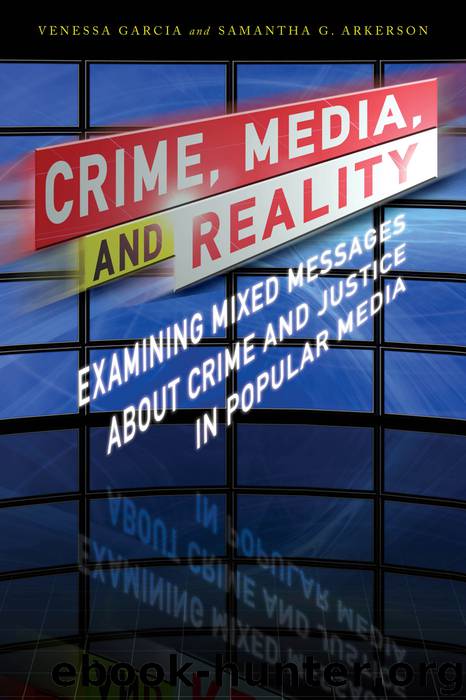Crime, Media, and Reality by Venessa Garcia & Samantha G. Arkerson

Author:Venessa Garcia & Samantha G. Arkerson
Language: eng
Format: epub
ISBN: 9781442260825
Publisher: Rowman & Littlefield Publishers
CULTIVATING CRIME IMAGES THROUGH TRUE-CRIME SERIES
Television true-crime series have been increasingly popular. This form of infotainment has also been called reality television and docudramas. Docudramas combine fiction and fact and tend to include reenactments. True-crime series give the appearance of objective reporting of true crimes. The presentation of the crimes using various camera angles and music typical in horror and action movies provides the entertainment the viewer is looking for.16 Though there are so many, some of the more popular true-crime series include America’s Most Wanted, People vs. O.J. Simpson: American Crime Story, City Confidential, Cold Case Files, Cops, Dateline, Forensic Files, Gangland, True Crime with Aphrodite Jones, Snapped, and The First 48. The crimes featured in these programs may take the audience through the criminal event or they may take the audience through the criminal’s life.
As with crime news, police tend to be the gatekeepers in the information-processing system. These programs use a forensic journalism approach, telling the story mostly through the eyes of law enforcement. Many also include scenes of reenactments of the crime. The resulting second-order cultivation is the belief that the truth can only be provided when the investigating detectives, the prosecutors, and the victims’ survivors tell the story. As the criminal is brought to light, we learn that greed, anger, and jealousy are the reasons for most crimes and that most crimes are very violent.
Examining the effects of true-crime series, we turn to the docudrama hypothesis that many researchers have adopted.17 This hypothesis claims that when you combine fiction and documentary, people’s conceptions of social and political reality are strongly influenced. Here the fiction tends to be the reenactments and the hard assumptions that the justice officials and victims’ survivors are providing accurate information. Research has found that the viewing of docudramas is selective (i.e., selective exposure and selective avoidance). This results in the re-enforcing spiral. Again, we see the binding and blinding of one’s preexisting belief systems. Sebastian Valenzuela and Angela Brandao argue that people are more likely to view programs that reinforce their belief systems and avoid those that negate them. This tends to increase polarization within society. In fact, we can see this polarization today in the many protests against police activities and political policies. Crime television tends to be conservative,18 law and order-oriented, seeming accurate in its portrayal, and does not present strongly opposing viewpoints. As a result, people who spend more of their time viewing these programs tend to be more conservative.
Download
This site does not store any files on its server. We only index and link to content provided by other sites. Please contact the content providers to delete copyright contents if any and email us, we'll remove relevant links or contents immediately.
| Anthropology | Archaeology |
| Philosophy | Politics & Government |
| Social Sciences | Sociology |
| Women's Studies |
Cecilia; Or, Memoirs of an Heiress — Volume 1 by Fanny Burney(32438)
Cecilia; Or, Memoirs of an Heiress — Volume 2 by Fanny Burney(31875)
Cecilia; Or, Memoirs of an Heiress — Volume 3 by Fanny Burney(31858)
The Great Music City by Andrea Baker(31516)
We're Going to Need More Wine by Gabrielle Union(18972)
All the Missing Girls by Megan Miranda(15590)
Pimp by Iceberg Slim(14398)
Bombshells: Glamour Girls of a Lifetime by Sullivan Steve(13978)
Talking to Strangers by Malcolm Gladwell(13232)
Norse Mythology by Gaiman Neil(13211)
Fifty Shades Freed by E L James(13162)
For the Love of Europe by Rick Steves(13094)
Mindhunter: Inside the FBI's Elite Serial Crime Unit by John E. Douglas & Mark Olshaker(9206)
Crazy Rich Asians by Kevin Kwan(9171)
The Lost Art of Listening by Michael P. Nichols(7411)
Enlightenment Now: The Case for Reason, Science, Humanism, and Progress by Steven Pinker(7240)
The Four Agreements by Don Miguel Ruiz(6637)
Bad Blood by John Carreyrou(6558)
Weapons of Math Destruction by Cathy O'Neil(6149)
